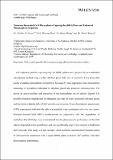Files in this item
Nanocone decorated ZnO microspheres exposing the (0001) plane and enhanced photocatalytic properties
Item metadata
| dc.contributor.author | Greer, Heather F. | |
| dc.contributor.author | Zhou, Wuzong | |
| dc.contributor.author | Zhang, Guan | |
| dc.contributor.author | Ménard, Hervé | |
| dc.date.accessioned | 2018-04-24T23:32:57Z | |
| dc.date.available | 2018-04-24T23:32:57Z | |
| dc.date.issued | 2017-07-07 | |
| dc.identifier | 249449899 | |
| dc.identifier | 43d31c27-9c22-4306-a247-16962f8ab21b | |
| dc.identifier | 85018732986 | |
| dc.identifier | 000405123200002 | |
| dc.identifier.citation | Greer , H F , Zhou , W , Zhang , G & Ménard , H 2017 , ' Nanocone decorated ZnO microspheres exposing the (0001) plane and enhanced photocatalytic properties ' , Advanced Materials Interfaces , vol. 4 , no. 13 , 1601238 . https://doi.org/10.1002/admi.201601238 | en |
| dc.identifier.issn | 2196-7350 | |
| dc.identifier.other | ORCID: /0000-0001-9752-7076/work/58054986 | |
| dc.identifier.uri | https://hdl.handle.net/10023/13195 | |
| dc.description | WZ thanks EPSRC for a platform grant (No. EP/K015540/1) and financial support to the Electron Microscopy Laboratory (No. EP/F019580/1) | en |
| dc.description.abstract | ZnO spherical particles exposing only the (0001) planes were prepared by an established solvothermal method using a water‒ethylene glycol (EG) mix as a solvent. It was found that poorly crystalline nanoparticles formed first, followed by their aggregation into microspheres consisting of crystallites embedded in ethylene glycol and precursor molecules/ions. The grown up nanocrystallites and nanocones in the microspheres are all radially aligned. The possible formation mechanisms, in particular, the roles of water molecules, ethylene glycol and the intrinsic dipolar field of ZnO crystals, are discussed. X-ray photoelecton spectroscopy (XPS) experiments indicated the spherical particles were terminated solely by zinc atoms. Brunauer-Emmett-Teller (BET) measurements in conjunction with the degradation of methylene blue (MB) dye data demonstrated that the photocatalytic performance of the ZnO spheres depended on the growth time and was significantly improved compared to traditional ZnO nanorods. This study is a rare example which combines nanostructural characterisation of ZnO particles terminated with a single (0001) plane of known Zn2+-polarity with their photocatalytic performance. | |
| dc.format.extent | 2561437 | |
| dc.language.iso | eng | |
| dc.relation.ispartof | Advanced Materials Interfaces | en |
| dc.subject | ZnO | en |
| dc.subject | Crystal growth | en |
| dc.subject | Electron microscopy | en |
| dc.subject | Photocatalysis | en |
| dc.subject | Polar surface | en |
| dc.subject | QD Chemistry | en |
| dc.subject | NDAS | en |
| dc.subject.lcc | QD | en |
| dc.title | Nanocone decorated ZnO microspheres exposing the (0001) plane and enhanced photocatalytic properties | en |
| dc.type | Journal article | en |
| dc.contributor.sponsor | EPSRC | en |
| dc.contributor.sponsor | EPSRC | en |
| dc.contributor.institution | University of St Andrews. School of Chemistry | en |
| dc.contributor.institution | University of St Andrews. EaSTCHEM | en |
| dc.identifier.doi | https://doi.org/10.1002/admi.201601238 | |
| dc.description.status | Peer reviewed | en |
| dc.date.embargoedUntil | 2018-04-24 | |
| dc.identifier.url | http://onlinelibrary.wiley.com/doi/10.1002/admi.201601238/full#footer-support-info | en |
| dc.identifier.grantnumber | EP/F019580/1 | en |
| dc.identifier.grantnumber | EP/K015540/1 | en |
This item appears in the following Collection(s)
Items in the St Andrews Research Repository are protected by copyright, with all rights reserved, unless otherwise indicated.

